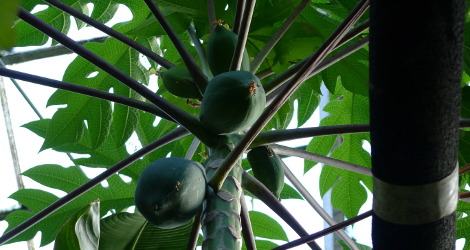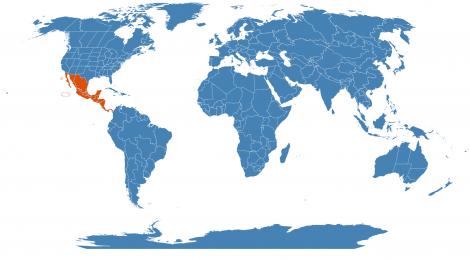Accession Data:
Carica papaya L.
- Common Name: Papaya, Pawpaw
- Family: Caricaceae Dum.
- Description: Carica is a genus of about 20 species of evergreen trees native to tropical America. They all produce a acrid milky sap. Although described as a tree, the plant is a large herb or soft-wood tree, like the banana.
Tree to 25 feet, glabrous leaves to 2 feet across, deeply palmately 7-lobed, the lobes pinnately lobed; flowers yellowish, to 1 inch long or more, male flowers slender, long-tubed, in long-peduncled, axillary racemes to 3 feet long, female flowers broader, solitary or few together, on short peduncles; male plants sometimes bearing a few female or bisexual flowers; fruit elongate to globose, with a central cavity, greenish-yellow to orange, to 20 inches long, with thick, yellow or orange flesh, seeds many, black.
[Thai: malakaw]
- Uses: Carica papaya contains an enzyme known as papain, present in the fruit, stem and leaves.The milky juice is extracted, dried and used as chewing gum, medicine (digestion problems), toothpaste and meat tenderizers. (Meat can be tenderized by wrapping it in a bruised papaya leaf before it is cooked.)
The fruit size varies from 4 to 20" and from 2 to 20 pounds. The flesh is soft and juicy, orange-yellow or salmon pink, surrounding a cavity containing numerous brown-black pea-size seeds which can be used as a spice (some people chew them). Unripe papaya can be cooked as a vegetable.
- IMPORTANT NOTE: Plant Uses are for informational purposes only. EEB Greenhouses assume no responsibility for adverse effects from the use of any plants referred to on this site. Always seek advice from a professional before using any plant medicinally.
- USDA Zone: 10-11
Accession Data:
- Accession # 200700092
- Source: Indiana University
- Accession Date: 06-26-2007
- Bench: 1311 - NEOA: Ground Bed 1 SE
- Currently: active - marginal (no foliage)
- Qty: 1 confirmed on 08-29-2020
Classification:
- Division: Magnoliophyta
- Class: Magnoliopsida
- SubClass: eurosid II
- Order: Brassicales
- SubOrder:
- Family: Caricaceae
- SubFamily:
- Tribe:
- SubTribe:
Flowering Data:
This accession has been observed in bloom on:| Year | Jan | Feb | Mar | Apr | May | Jun | Jul | Aug | Sep | Oct | Nov | Dec | ||||||||||||||||||||||||||||||||||||||||
|---|---|---|---|---|---|---|---|---|---|---|---|---|---|---|---|---|---|---|---|---|---|---|---|---|---|---|---|---|---|---|---|---|---|---|---|---|---|---|---|---|---|---|---|---|---|---|---|---|---|---|---|---|
| 2020 | ||||||||||||||||||||||||||||||||||||||||||||||||||||
| 2019 | ||||||||||||||||||||||||||||||||||||||||||||||||||||
| 2018 | ||||||||||||||||||||||||||||||||||||||||||||||||||||
| 2017 | ||||||||||||||||||||||||||||||||||||||||||||||||||||
| 2016 | ||||||||||||||||||||||||||||||||||||||||||||||||||||
| 2015 | ||||||||||||||||||||||||||||||||||||||||||||||||||||
| 2014 | ||||||||||||||||||||||||||||||||||||||||||||||||||||
| 2013 | ||||||||||||||||||||||||||||||||||||||||||||||||||||
| 2012 | ||||||||||||||||||||||||||||||||||||||||||||||||||||
| 2011 | ||||||||||||||||||||||||||||||||||||||||||||||||||||
| 2010 | ||||||||||||||||||||||||||||||||||||||||||||||||||||
| 2009 | ||||||||||||||||||||||||||||||||||||||||||||||||||||
References (internal):
- EEB Greenhouse Holdings native to: Mexico Central / Mexico Northeast / Mexico Gulf / Mexican Pacific Is. / Mexico Northwest / Mexico Southwest / Mexico Southeast / Belize / Costa Rica / El Salvador / Guatemala / Honduras / Nicaragua / Panama
References (external):
- Hortus Third, LH Bailey Hortorium, 1976
- California Rare Fruit Growers WWW Site
- The Plant List (2013). Version 1.1. Last accessed on Tuesday, May 31, 2016.
- Carica papaya at ARS-GRIN. Last accessed on Thursday, October 26, 2017.
data regenerated on Wed, 23 Sep 2020 22:25:07 -0400 [bcm v4.0]
Images:

Additional images for this accession:
Click on thumbnails to enlargeCurrent Accessions in the Caricaceae
W/C = Wild Collected = indicates flowering in past 14 days
= indicates flowering in past 14 days
 = images available for this accession
= images available for this accession
 = map available for this accession
= map available for this accession
 = accession added within past 90 days
= accession added within past 90 days


